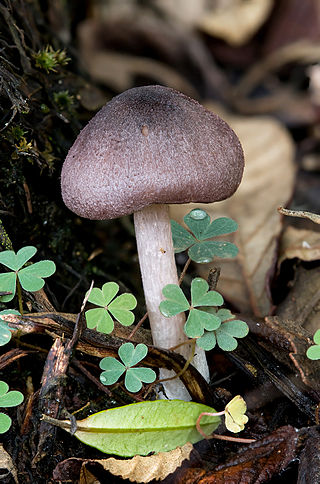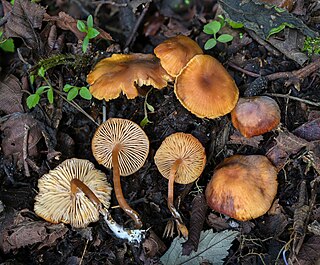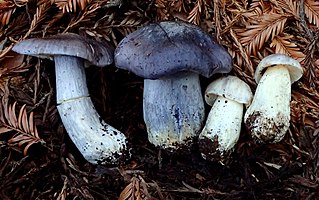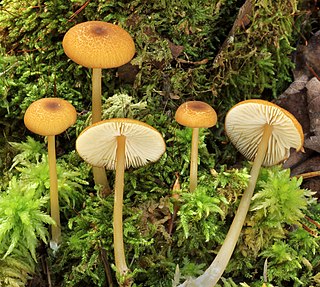
Entoloma sinuatum is a poisonous mushroom found across Europe and North America. Some guidebooks refer to it by its older scientific names of Entoloma lividum or Rhodophyllus sinuatus. The largest mushroom of the genus of pink-spored fungi known as Entoloma, it is also the type species. Appearing in late summer and autumn, fruit bodies are found in deciduous woodlands on clay or chalky soils, or nearby parklands, sometimes in the form of fairy rings. Solid in shape, they resemble members of the genus Tricholoma. The ivory to light grey-brown cap is up to 20 cm (7.9 in) across with a margin that is rolled inward. The sinuate gills are pale and often yellowish, becoming pink as the spores develop. The thick whitish stem has no ring.

Entoloma is a genus of fungi in the order Agaricales. Called pinkgills in English, basidiocarps are typically agaricoid, though a minority are gasteroid. All have salmon-pink basidiospores which colour the gills at maturity and are angular (polyhedral) under a microscope. The genus is large, with almost 2000 species worldwide. Most species are saprotrophic, but some are ectomycorrhizal, and a few are parasitic on other fungi. The type, Entoloma sinuatum, is one of several Entoloma species that are poisonous, typically causing mild to severe gastrointestinal illness.

The Entolomataceae are a family of fungi in the order Agaricales. The family contains eight genera and 2250 species, the majority of which are in Entoloma. Basidiocarps are typically agaricoid, but a minority are cyphelloid. secotioid, or gasteroid. All produce pink basidiospores that are variously angular (polyhedral), ridged, or nodulose. Species are mostly saprotrophic, though a few are parasitic on other fungi. The family occurs worldwide.

Nolanea is a subgenus of fungi in the order Agaricales. Called pinkgills in English, basidiocarps are agaricoid, mostly mycenoid with slender stems. All have salmon-pink basidiospores which colour the gills at maturity and are angular (polyhedral) under a microscope. Recent DNA evidence has shown that at least 87 species belong to the subgenus Nolanea which has a worldwide distribution.

Rhodocybe is a genus of fungi in the family Entolomataceae. Basidiocarps are agaricoid producing pink basidiospores that are unevenly roughened or pustular under the microscope. Species are saprotrophic and mostly grow on the ground, occasionally on wood. The genus is distributed worldwide.

Entoloma austroprunicolor is a species of agaric fungus in the family Entolomataceae. Described as new to science in 2007, it is found in Tasmania, where it fruits on the ground of wet sclerophyll forests in late spring to early winter. The fruit bodies (mushrooms) have reddish-purple caps measuring up to 5 cm (2.0 in) in diameter supported by whitish stipes measuring 3–7.5 cm (1.2–3.0 in) long by 0.2–0.6 cm (0.1–0.2 in) thick. On the cap underside, the crowded gills are initially white before turning pink as the spores mature.
Clitopilus byssisedoides is a species of fungus in the family Entolomataceae. It was formally described as new to science in 2010, based on specimens found growing in a greenhouse in Botanischer Garten Jena, in Germany.

Tricholoma columbetta, commonly known as dove-coloured tricholoma, is an edible mushroom of the large genus Tricholoma. It is found in Europe, where it is eaten in France.
Machiel Evert Noordeloos is a Dutch mycologist. He is known for his contributions to the taxonomy of European mushrooms and especially his expertise on the genus Entoloma. Noordeloos is an assistant professor at the Nationaal Herbarium Nederland, and has served as the editor of the mycological journals Persoonia since 1991 and Coolia since 1976. He was in 2011 the editor in chief of Persoonia. He was the recipient of the Clusius Prize awarded by the Hungarian Mycological Society in 2009.

Entoloma bloxamii, commonly known as the midnight blue entoloma, or big blue pinkgill, is a species of agaric in the family Entolomataceae. The species has a European distribution, occurring mainly in agriculturally unimproved grassland. Entoloma bloxamii has been reported from North America, but at least some of these reports represent a distinct species, Entoloma medianox. Threats to its habitat have resulted in the Big Blue Pinkgill being assessed as globally "vulnerable" on the IUCN Red List of Threatened Species.

Rhodocybe gemina is a species of fungus in the family Entolomataceae. It has the recommended English name of tan pinkgill and produces agaricoid basidiocarps that are fleshy and cream when young, becoming brownish when mature.

Psilocybe medullosa is a species of psychoactive mushroom. It was originally described in 1898 as Naucoria medullosa by Italian mycologist Giacomo Bresadola. Czech mycologist Jan Borovička transferred it to Psilocybe in 2007. A widespread but rather rare species, it is found in Europe, where it grows as a saprobe on woody debris and detritus. Chemical analysis has been used to confirm the presence of the psychedelic compounds psilocin and psilocybin in the fruit bodies but probably at low levels. Psilocybe silvatica is its American sister species; it differs by subtle changes in molecular markers.

Entoloma holoconiotum is a mushroom in the family Entolomataceae. It was originally described as Nolanea holoconiota by David Largent and Harry Thiers in 1972. Machiel Noordeloos and Co-David transferred it to the genus Entoloma in 2009. The species can be found in conifer forests in western North America.

Rhodophana is a genus of mushroom-forming fungi in the family Entolomataceae. It originally described as a genus in 1947 by Robert Kühner, but the description was invalid until it was re-published in 1971, though as a subgenus of Rhodocybe. It did not find favour as a genus until Rhodocybe was found to be polyphyletic and Kluting et al. resurrected the name in 2014 as part of a DNA-based reclassification of the family.

Entoloma medianox is a species of agaric in the family Entolomataceae. It is known from western North America, where it was previously referred to the European species Entoloma bloxamii or E. madidum. Molecular research, based on cladistic analysis of DNA sequences, has, however, shown that Entoloma medianox is distinct.

Entoloma prunuloides is a species of agaric in the family Entolomataceae. It has been given the recommended English name of Mealy Pinkgill, based on its distinctive smell. The species has a European distribution, occurring mainly in agriculturally unimproved grassland. Threats to its habitat have resulted in the Mealy Pinkgill being assessed as globally "vulnerable" on the IUCN Red List of Threatened Species.

Entoloma griseocyaneum is a species of agaric in the family Entolomataceae. It has been given the recommended English name of Felted Pinkgill. The species has a European distribution, occurring mainly in agriculturally unimproved grassland. Threats to its habitat have resulted in the Felted Pinkgill being assessed as globally "vulnerable" on the IUCN Red List of Threatened Species.

Entoloma eugenei is a species of agaric in the family Entolomataceae. The species has a temperate distribution in the Russian Far East, Japan, and Korea, occurring mainly in mixed hardwood forests.Threats to its habitat have resulted in Entoloma eugenei being assessed as globally "endangered" on the IUCN Red List of Threatened Species.

Entoloma formosum is a inconspicuous yellowish-brown mushroom in the family Entolomataceae which are distinguished by their pink angular spores.
















